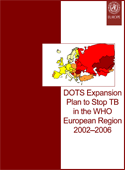DOTS Expansion Plan to Stop TB in the WHO European Region 2002–2006

Download
2002, v + 46 pages
ISBN 92 890 1367 2
This publication is only available online.
Tuberculosis, an ancient disease once believed to have disappeared from the WHO European Region, affects more people today than two decades ago. Currently, more than three quarters of the TB cases in the Region occur in the newly independent states, where TB rates more than doubled in 10 years. In these countries, the disease occurs mainly in young men, prisoners, alcoholics and other socially disadvantaged people. Although TB strikes hardest in the eastern part of the Region, not one western European country has managed to reduce its TB rates to the elimination level in recent years, and TB rates have even increased in some countries. In western Europe, TB mainly affects elderly people and migrants.
All countries should commit themselves to fighting TB. As a result of the growing political commitment to TB control, and to carry out the recommendations of the Global DOTS Expansion Plan, the DOTS Expansion Plan to Stop TB in the WHO European Region was developed. The WHO Member States in the European Region endorsed this Plan at the fifty-second session of the WHO Regional Committee for Europe in September 2002. The Plan provides a template for the mobilization and coordination of human and financial resources needed to expand sound TB control in the Region in order to achieve WHO’s global TB targets.



